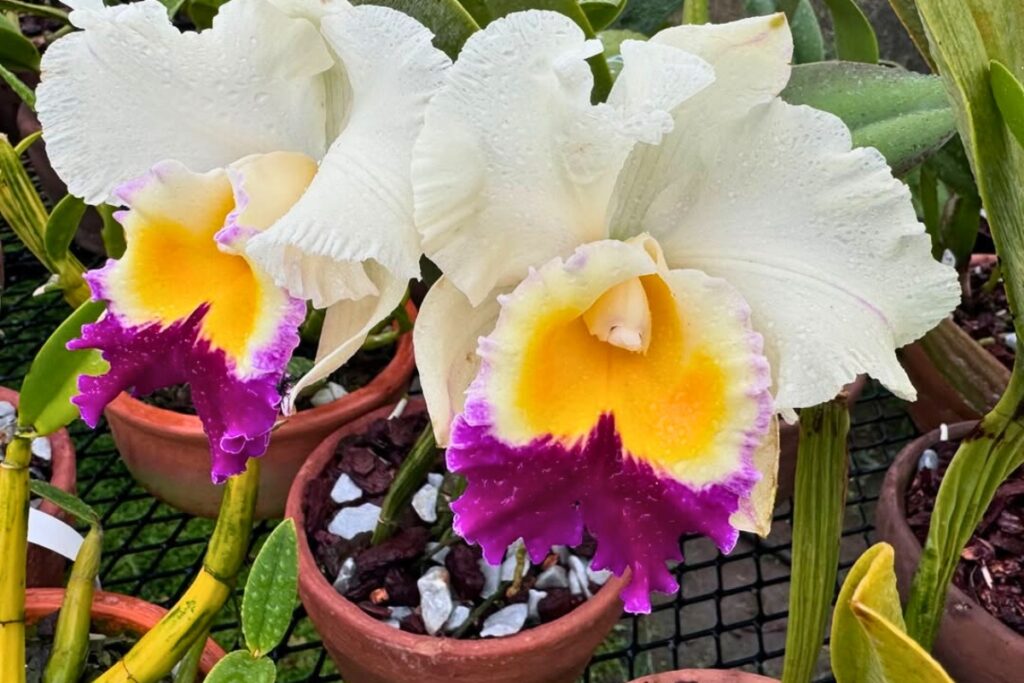Just as a house needs a solid foundation, your Cattleya orchid’s success begins with choosing the perfect potting medium. You’ll quickly discover that these elegant epiphytes don’t thrive in ordinary potting soil – they need a specialized mix that mirrors their natural growing conditions in the wild. While the classic fir bark blend has served orchid growers well for decades, you might be surprised to learn about some innovative alternatives that could work even better for your specific situation.

Contents
Understanding Cattleya Root Requirements
Before you can select the perfect potting medium for your Cattleya orchids, you’ll need to understand how their roots function in nature. These epiphytic orchids grow on tree branches in tropical environments, where their thick, white roots remain exposed to air and rainfall while clinging to rough bark.
Your Cattleya’s roots serve two critical functions: anchoring the plant and absorbing nutrients. The outer layer, called velamen, acts like a sponge that quickly soaks up water when it’s available, while the inner core conducts moisture to the rest of the plant. This unique structure means they’ll need a potting medium that provides both excellent drainage and airflow.
Traditional Bark-Based Potting Mixes
Bark-based potting mixes have been the gold standard for Cattleya orchids since the 1950s, perfectly mimicking their natural growing conditions. You’ll find medium-grade fir bark as the primary component, typically sized between 1/2 to 3/4 inch chunks.
When selecting your bark mix, you’ll want to look for a blend that includes perlite and charcoal in a 5:1:1 ratio. The perlite improves drainage, while charcoal helps maintain a healthy pH balance and prevents root rot.
Fresh bark mixes typically last 18-24 months before breaking down. You’ll know it’s time to repot when the medium becomes dark and compacted.
Alternative Growing Media Options
While traditional bark mixes remain popular, you’ll find several effective alternatives for growing healthy Cattleya orchids. Semi-hydroponics using LECA (Lightweight Expanded Clay Aggregate) pellets offers excellent root aeration, while sphagnum moss provides superior moisture retention for humid environments.
You can also experiment with coconut husk chips, which break down more slowly than bark and hold moisture effectively. Mix them in a 3:1 ratio with perlite for ideal drainage. For mounting enthusiasts, tree fern fiber or cork slabs create natural growing conditions that mimic these epiphytes’ native habitat.
Selecting the Right Medium for Your Climate
Knowing your local climate conditions will determine the most suitable potting medium for your Cattleya orchids. If you’re in a humid region (above 60% humidity), you’ll want to use a faster-draining mix with more bark and less moisture-retaining materials, typically in a 70:30 ratio of bark to perlite.
For drier climates (below 40% humidity), you’ll need a medium that retains more moisture. Consider using a mix with finer bark particles, sphagnum moss, and coconut chips in a 50:30:20 ratio. In moderate climates, you can opt for a balanced medium that’s 60% bark, 20% perlite, and 20% charcoal.
Repotting and Medium Maintenance Tips
Once you’ve selected the right potting mix for your climate, proper repotting techniques will keep your Cattleya orchids thriving. Start by removing the old medium completely, trimming dead roots, and sterilizing your tools with 70% isopropyl alcohol.
Pre-soak your fresh medium for 24 hours, then fill the new pot one-third full. Position your orchid so the rhizome sits 1/2 inch below the pot’s rim, and gently work the medium around the roots. Don’t pack too tightly – you’ll want about 30% air space throughout.
Water thoroughly and stake the plant if needed. You’ll notice the medium breaks down after 18-24 months, signaling it’s time to repot again.
